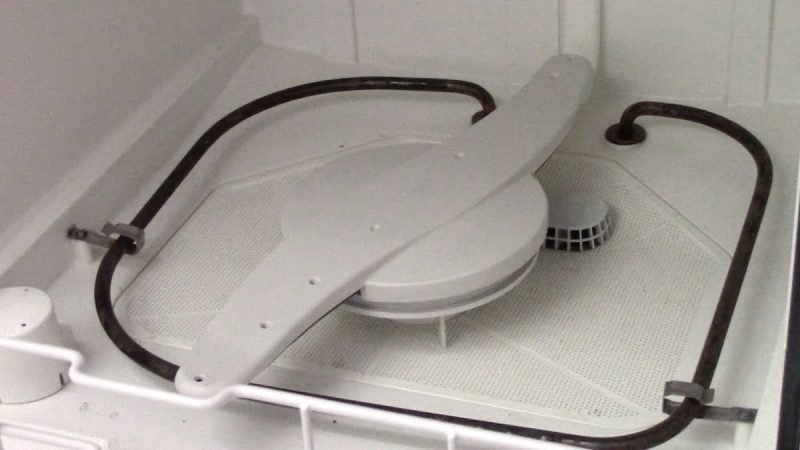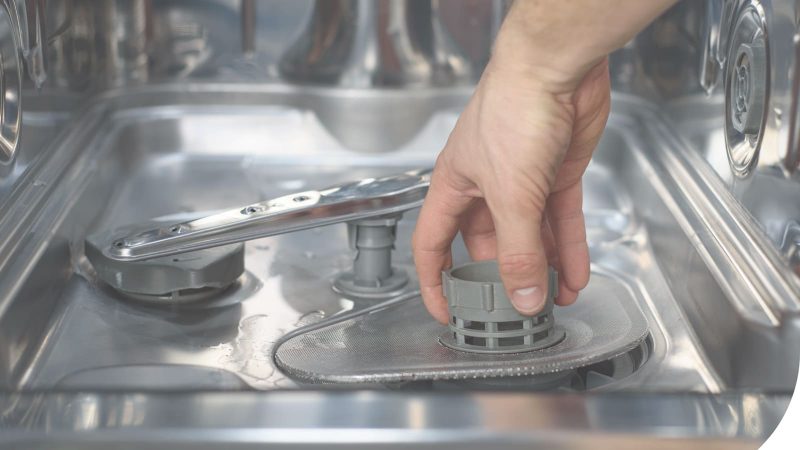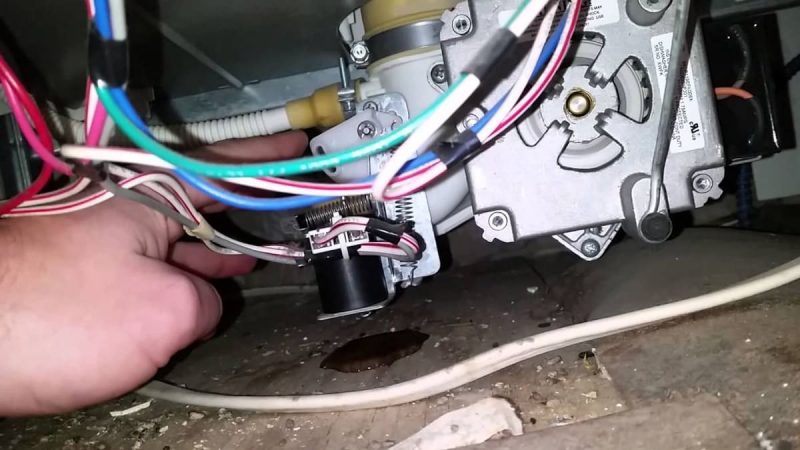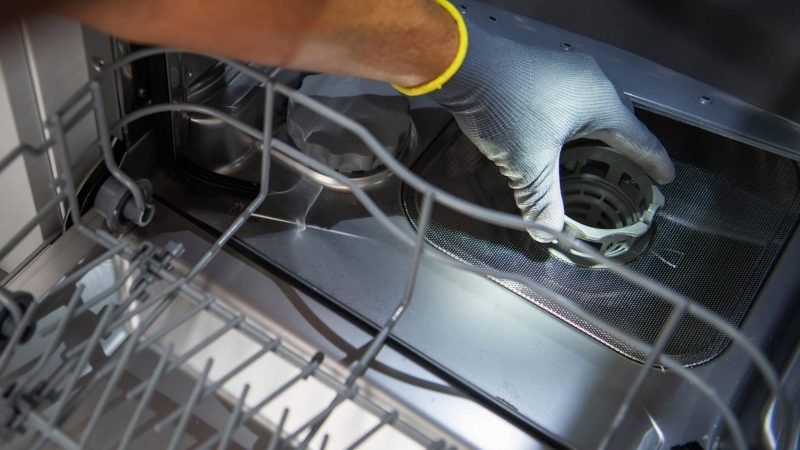A small amount of water at the bottom of the dishwasher is normal. But if its level exceeds 1 cm, you need to pay attention to this and take measures to avoid undesirable consequences.
Please note: most often, the problem of excess water is caused by a drain pump motor jamming and clogging the hose under the sink with food debris. Before placing the dishes in the machine, they must be cleaned of food.
Other causes: clogged air gap, damaged pump motor, damaged pump impeller, improperly positioned drain hose. It must be placed at a level below 1 meter from the floor.
The dishwasher has stopped draining water: a detailed analysis
First, try to deal with the problem yourself. Use the tips below. If all else fails, call the wizard.
Check for blockage
First, check if there is a blockage in the system. Inspect the installed filters, if they are clogged, remove and remove all debris. Do not knock on them, so as not to provoke their curvature, which will lead to malfunctions. In general, you should inspect the filters for damage/blockage before each use of the washer.
The filters effectively remove food particles from the water during the cleaning process, allowing the dishes to circulate unhindered. Large particles are best removed after each wash by washing the filters under water pressure.
The entire filter system must be freed from accumulated particles at least once a week. Coarse and fine filters are brushed.
Have you checked your filters? Make sure that there are no large pieces of food, napkins and other debris at the bottom of the dishwasher.
Also inspect the drain hose. It should be even, without kinks. Straighten it if it’s twisted.
Unscrew the siphon sump cover. Remove all dirt from there. Be prepared for an unpleasant smell. Lay down a rag or paper towels before unscrewing the lid, because some of the water will spill out.
If an old hose or a hose longer than 4 meters was used during the installation and connection of the machine, this may also cause water to form at the bottom of the machine.
Faulty drain pump impeller
The impeller often becomes the reason why the machine does not drain the water in full. It performs a simple function – it pushes water flows through the drain hose due to the pressure generated from high rotation. If the blockage is severe, the impeller may not be able to cope with the task and fail.
If this happens, you need to replace the drain pump completely. How to do it:
- Turn off the power to the dishwasher, turn off the water supply.
- Disconnect the mounting fasteners, pull out the machine to gain access to the bottom, carefully place it on the floor so that the front is on top.
- Remove harnesses from drain solenoid and motor.
- Loosen the clamp leading to the sump, as well as the pump outlet to the central nozzle.
- Remove the drain hose clamp. Since there will most likely be water in the hose, prepare a bucket or basin in advance.
- Inspect engine support collar. Tilt the engine towards you and disconnect from the tank.
Next, sequentially disconnect the cutter blade, grater, wear ring retainer and the ring itself, the impeller. Then remove the pump from the engine, remove the old seal, get rid of the blockage, flush all the parts and reassemble them in reverse order.
Faulty drain pump
The impeller in the drain pump is used to create the pressure needed to move water through the hose. If the pump is not working, water will remain inside.
Use a multimeter to test the drain pump. Use it to determine if there is continuity. If there is, everything is fine, if not, replace the pump, as it cannot be repaired.
Faulty solenoid valve
Another common reason why the drain stops working is the failure of the drain solenoid located inside the valve. He is responsible for opening or closing the damper, as a result of which the inflow and outflow of water from the dishwasher is controlled.
To check this node, turn off the power to the equipment and remove the bottom panel. Pay attention to the main pump. The solenoid is attached to it. Get under the car and click on it.
If the sodenoid does not move, it must be replaced. If there is movement, then the resource has not been developed. Do the following:
- Plug in the dishwasher.
- Start a wash cycle.
- If you have a mechanical timer: turn it slowly until the solenoid turns on. Nothing happens – put in a new solenoid.
- If the machine is controlled electronically: start the wash cycle, wait a few seconds, press the Reset/Start button. This will activate the solenoid.
If you don’t notice any change, replace the solenoid.
Non-working drain check valve
Clogged drains with debris and leftover food happen regularly. When checking this assembly, you need to pay attention to the drain valve. Over time, it can become clogged and stop working.
First of all, you need to remove all the garbage from it. If after that the valve does not work, replace it. This item cannot be repaired.
Food waste clogged the area around the chopper blade
To make the system clogged as little as possible, the manufacturer integrates a waste chopper into dishwashers. It breaks large parts into small fractions, after which they are freely removed outside.
If a lot of debris has accumulated near the chopper mesh, the water may stop draining, which will lead to an unpleasant odor and other undesirable consequences.
To fix the problem, you need to remove the blockage and check the blade for damage. If its integrity is broken, replace the element.
Instructions for replacing the chopper blade:
- Turn off the power to the appliance, remove both shelves of the dishwasher, set them aside.
- Unscrew the lock nut of the lower gun, lift it up.
- Locate the clips located on the sides of the spray tower (it is attached to the back of the tank). Click on them and remove the tower.
- Remove the lower sprinkler bearing.
- Remove the filter housing and pump cover fasteners.
After these manipulations, you will see a chopper. Remove the assembly cover, inspect the blade for damage, and replace if necessary. Also remove any accumulated deposits.
Perform work only if you are confident in your abilities and have some experience. The instructions above are intended to help you identify the problem and fix it if possible. If you don’t understand anything or in the process of working you find that you can’t handle it yourself, call a specialist or take the dishwasher to a service center. While it will be under repair, you will have to wash the dishes as before – by hand.
If you do not want to face such inconveniences, follow the manufacturer’s recommendations for caring for equipment, namely:
- Place the dishes correctly so that the water drains completely from them after washing.
- Remove large food residues from dishes and any other items that may clog and damage the dishwasher.
- Connect the machine to the water supply using a new set of hoses. Old ones are not allowed.
- When connecting the machine, follow the manufacturer’s recommendations.
In general, installation and connection work should be carried out by specialists who know plumbing and electrics. The only problem you may encounter is poor performance. Therefore, contact only proven masters.




